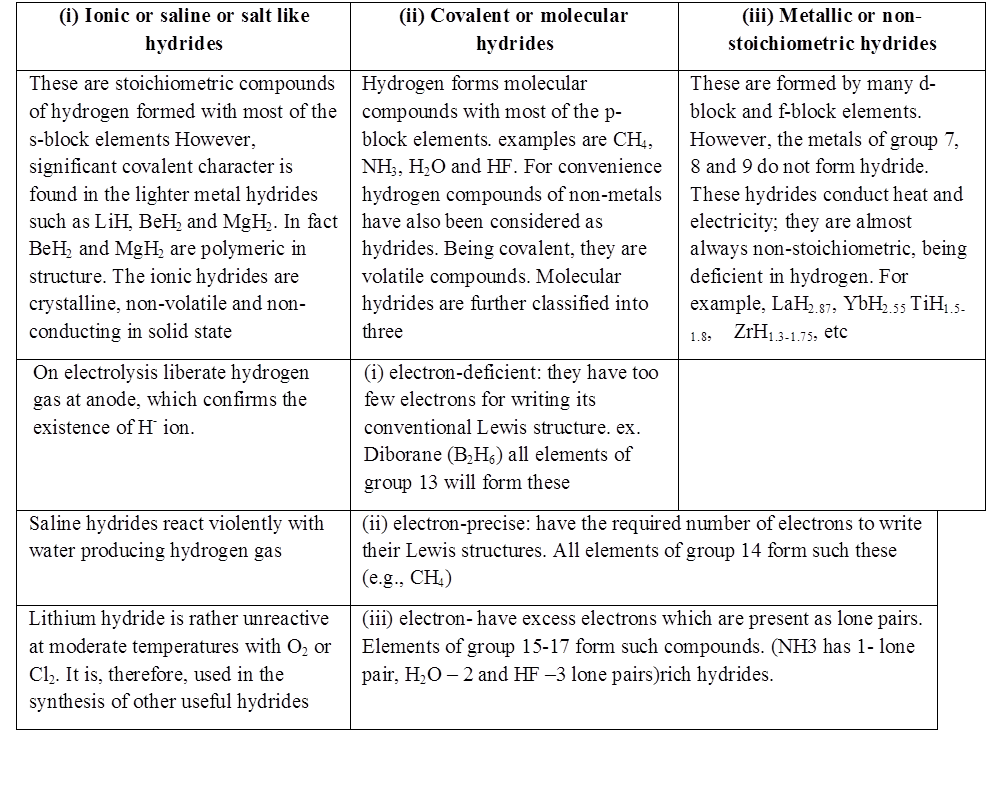- Books Name
- Kaysons Academy Chemistry Book
- Publication
- Kaysons Publication
- Course
- JEE
- Subject
- Chemistry
HYDROGEN
- Hydrogen is the lightest element known since it has an atomic mass of 1.0079
- Hydrogen resembles Group 1 elements
- Hydrogen also resembles elements of group 17 (Halogens)
- (H+) is of size ~10–5 Ao. This is extremely small as compared to normal atomic and ionic sizes of ~1 Ao. As a consequence, H+ does not exist freely and is always associated with other atoms or molecules.
- Thus, it is unique in behaviour and is, therefore, best placed separately in the periodic table
OCCURRENCE
It is the most abundant element in the universe (70% of the total mass of the universe). It is much less abundant (0.15% by mass) in the earth’s atmosphere. Of course, in the combined form it constitutes 15.4% of the earth's crust and the oceans

H is the predominant form 99.98%
D is (0.0156% of total)
T. (one atom per 1018 atoms)
Tritium is radioactive and emits low energy ß particles (t½, 12.33 years).
Preparation of Hydrogen Gas
Laboratory Preparation
(i) Zn + 2H+ ® Zn2+ + H2
(ii) Zn + 2NaOH ® Na2ZnO2(Sodium zincate) + H2
Commercial Production
(i) Electrolysis of acidified water using platinum electrodes gives hydrogen.
(ii) High purity (>99.95%) hydrogen is obtained by electrolysing warm aqueous barium hydroxide solution between nickel electrodes
(iii) By the electrolysis of brine solution.
anode: 2Cl–(aq) ® Cl2(g) + 2e–
cathode: 2H2O (l) + 2e– ® H2(g) + 2OH–(aq)
2NaCl (aq) + 2H2O(l) ®Cl2(g) + H2(g) + 2NaOH(aq)
Water gas: - is the mixture of CO and H2
Water-gas shift reaction
C(s) + H2O 1000°CNi CO + H2 CO(g) + H2O 400°Ciron cromate
CO + H2 CO(g) + H2O 400°Ciron cromate CO2 + H2
CO2 + H2
PROPERTIES OF HYDROGEN
Physical Properties
- Hydrogen gas is a colourless, odourless, tasteless, highly combustible gas.
- It is lighter than air and insoluble in water.
Chemical Properties
- The H–H bond dissociation enthalpy is the highest for a single bond between two atoms of any element. it is relatively inert at room temperature.
- Since its orbital is incomplete with 1s1 electronic configuration, it does combine with almost all the elements. It accomplishes reactions by
- loss of the only electron to give H+,
- gain of an electron to form H–, and
(iii) sharing electrons to form a single covalent bond
(i) Reaction with halogens
H2(g) + X2(g) ® 2HX(g), While the reaction with fluorine occurs even in the dark, with iodine it requires a catalyst.
(ii)Reaction with oxygen
2H2(g) + O2 (g) ® 2H2O(l); DH = –285.9 kJ mol–1
(iii) Reaction with nitrogen
3H2(g) + N2(g) 400°Ciron 2NH3(g)
2NH3(g)
(iv) Reactions with metals:
it forms corresponding hydrides H2(g) +2M(g) ® 2MH(s); where M is an alkali metal
(v) Reactions with metal ions and metal oxides:
It reduces some metal ions in aqueous solution and oxides of metals (less active than iron) into corresponding metals.
H2(g) + Pd++(aq) ® Pd(s) + 2H+(aq)
yH2(g) + MxOy(s) ® xM(s) + yH2O(l)
(vi) Reactions with organic compounds:
It reacts with many organic compounds in the presence of catalysts to give useful hydrogenated products of commercial importance
USES OF HYDROGEN GAS
1. The single largest use of hydrogen is in the synthesis of ammonia which is used in the manufacture of nitric acid and nitrogenous fertilizers.
2. Hydrogen is used in the manufacture of vanaspati fat by the hydrogenation of polyunsaturated vegetable oils like soybean, cotton seeds etc.
3. It is used in the manufacture of bulk organic chemicals, particularly methanol.
4. It is widely used for the manufacture of metal hydrides.
5. It is used for the preparation of hydrogen chloride, a highly useful chemical.
6. In metallurgical processes, it is used to reduce heavy metal oxides to metals.
7. Atomic hydrogen and oxy-hydrogen torches find use for cutting and welding purposes. Atomic hydrogen atoms (produced by dissociation of hydrogen with the help of an electric arc) are allowed to recombine on the surface to be welded to generate the temperature of 4000 K.
8. It is used as a rocket fuel in space research.
9. Hydrogen is used in fuel cells for generating electrical energy. It has many advantages over the conventional fossil fuels and electric power. It does not produce any pollution and releases greater energy per unit mass of fuel in comparison to gasoline and other fuels.
HYDRIDES
Hydrogen, under certain reaction conditions, combines with almost all elements, except noble gases, to form binary compounds, called hydrides. If ‘E’ is the symbol of an element then hydride can be expressed as EHX (e.g., MgH2) or EXHY (e.g., B2H6)
The hydrides are classified into three categories:


 Kaysons Publication
Kaysons Publication
